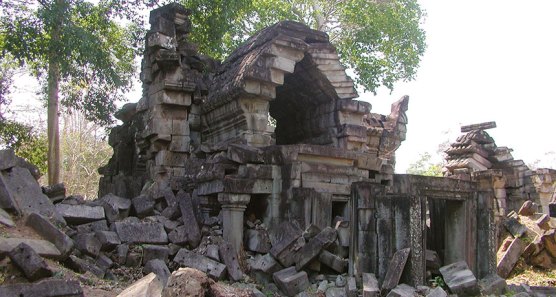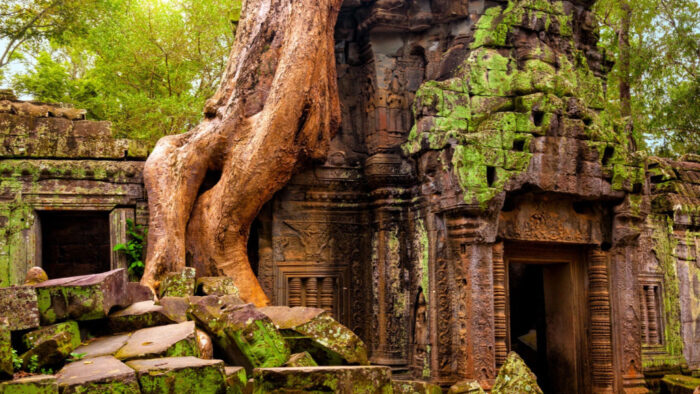Many of us have experienced that the Kingdom of Cambodia glitters with the old temples. Visitors of Angkor always appreciate the Ta Prohm temple, which was built during the time of King Jayavarman VII in the 12th century to honor his mother, now situated in jungle ruins, and famous for its giant banyan roots, which tightly grip the temple walls. This image was a most favorite one, which could capture in several paintings and photographs. But today almost all temples in Cambodia have collapsed and fallen down. No temple is perfectly standing today and no temple is functioning today, with its past glory. Very few temples may be the exceptions for this.

Though Cambodians possess the great legacy, they are not the masters of temple preservation. They hold the keys but not the essential resources. China came to help Cambodia but it couldn’t play a considerable role in conservation of Cambodian old temples. The Chinese government was handed control over Chau Sey Tevoda, because it is generally assumed, that the China maintains close links with Cambodia’s monarch, King Norodom Sihanouk, who spent at least half his life time in a government villa near Beijing.
Anyone who loves ancient Indian culture, which was spread across the Cambodia, becomes extremely happy to see the great ancient temples of Cambodia, but feels astonishing to observe the present pitiable condition of ancient Hindu and Buddhist temples, which were the shining places of social gatherings and number of arts, in ancient Cambodia. These temples were undivided part of Cambodian culture and inspiring places for all Cambodian people.
The L’École Française d’Extrême-Orient, the top French research institute, enjoyed 100 years of supremacy in Cambodia. It meticulously restored around 50 monuments, but had no worries about predatory artifacts, which it treated its patrimony for French museums. The French had left a number of projects unfinished due to the rise of Khmer Rouge in the early 1970’s. Cambodia, under the Communism in the 1980’s, had invited a few ”friendly” countries onto the site, like Poland and Russia and it is not difficult to expect what they might have suggested for the preservation of ancient Hindu and Buddhist temples.
Several European countries including Japan came to restore the Cambodian temples, but the restoring a Khmer ruins is like attempting terrifying puzzles, with almost all collapsed or collapsing structures. How to fill the gaps with newly recycled stone, and how much to decorate them, are some of the crucial questions. The Ta Prohm’s big trees present another question: to cut or not to cut them.
Today several temples in Cambodia have collapsed. Many temples are dilapidated and not functioning today as temples. They are just tourist visiting spots, where every foreigner has to pay several dollars to enter into these sacred premises. There was a seven percent growth in tourist arrivals in the year of 2018 and visitors from 193 countries visited the temple of Angkor watt. Angkor Archaeological Park continues to generate the bulk of tourism revenue from its ticket sales. The income could be $117 million annually, with about 2.6 million foreigners visiting the Angkor Watt, located in Siem Reap. But citizens or any world citizen shouldn’t put a question how much money is being spent to rebuilt these temples. Authorities or researchers are not bothered how several temples in Cambodia have collapsed? Many temples are dilapidated and not functioning today as temples.
Several temples were also constructed in India, during the same time i.e. from A. D. 10th to 14th centuries. But the temples constructed in the same time period in India are still sound and also functioning in India, even today. Therefore the question remains, what made these temples to collapse in a large manner ! I tried to know the reason for this phenomena from the Cambodian monks and scholars but they said, it happened due to bombing during the wars.
There can be other reasons, one of the reasons may be the shifting or transforming of temple function. Ancient temples changed from Hinduism and Mahayana Buddhism to Theravada Buddhism. The other reason may be, temples were not provided the frequent action of protection by the government. Some scholars say, this might have happened due to wars with Thailand, and thereby due to the abandoning of the temple cities. People escaped from the temple area to find the safe refuge, so the temples are completely abandoned, then covered up by the forests. But the question remains, if the temples are completely abandoned, do they collapse?
The role of some temples in Cambodia is only “Nak ta”, which means the spirit of ancestors. People only celebrate the ceremony annually and eventually, some temples are abandoned due to the migration of people. As we know, the ancient temples constructed by the stones are very heavy on the earth, so they can stand according to the reservoirs, which were constructed around them. The mud has to be removed from these reservoirs from time to time, but if they become gutters, then the temple may collapse. The other reason may be the quality of stone, which was used for the construction of the temples.
Whatever may be the causes, the fact is, today almost all temples in Cambodia have collapsed and fallen down. No temple is perfectly standing today and no temple is functioning today, with its glory. Very few temples may be the exceptions. A Buddhist temple under construction in Siem Reap, which is the home of Cambodia’s famous Angkor temples, collapsed on Monday, Dec 2nd, 2019, killing at least three people and injuring 13 others, including two monks. Workers were pouring cement for the ceiling of the temple when it suddenly collapsed, trapping the workers and two monks who were helping them. This was an unfortunate incident, which occurred due to the collapse of temple. But several people who are lovers of ancient culture of Cambodia wish that these temples of Buddha, Vishnu, Shiva and Ganesh must be restored and they should function and opened for the devotees, the way they were functioning and opened for the devotees in ancient Cambodia.




